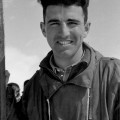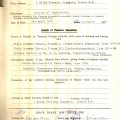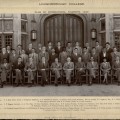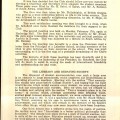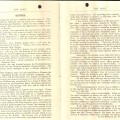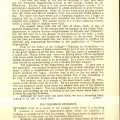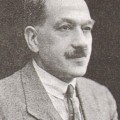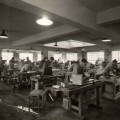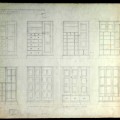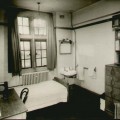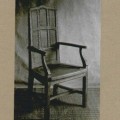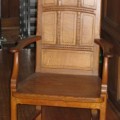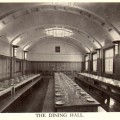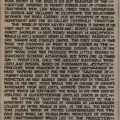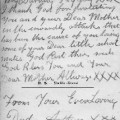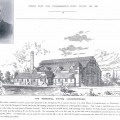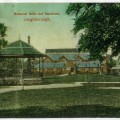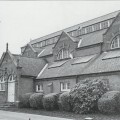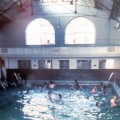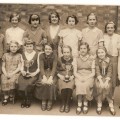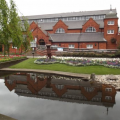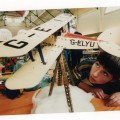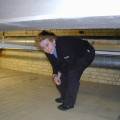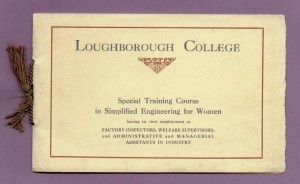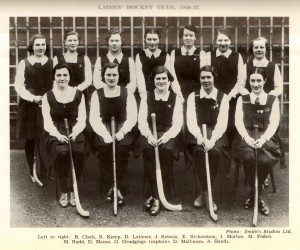Walter Freud – from Loughborough College to the Special Operations Executive
29 September 2014
- Walter Freud (photograph courtesy of Helen Fry)
- Walter Freud’s admission form to Loughborough College, 1939
- Photo from University archives of The Club of International Students, 1947. Freud stands 7th from the left on the back row.
- The Limit, 1947
- An article by Freud in the College publication ‘The Limit’, March 1947
- Freud’s 1948 article in ‘The Limit’ on the ‘Cinderella’ status of the Chemical Engineering course
In 1938, after Austria had been absorbed into the Third Reich, international pressure persuaded the Nazis to allow the famous psychoanalyst Sigmund Freud and his family to leave Vienna for London. Among them was Freud’s sixteen year old grandson, Anton Walter Freud. After a year of private tuition, Walter Freud entered Loughborough College in September 1939 to study Aeronautical Engineering. During the summer term, when he was in the middle of a mathematics examination, the police arrived and arrested him as an enemy alien. He was sent to an internment camp in Australia and only allowed back to England a year later in August 1941.
As an ex-enemy alien the only army unit Walter could join was the Pioneer Corps, where he served until recruited to the Special Operations Executive’s (SOE) Austria section in 1943. In spring 1945 he and a colleague left their base in Italy and were parachuted into Austria to encourage local anti-Nazi resistance. Freud lost contact with his companion but made his way alone to the intended target. In full uniform, with the help of friendly locals, he proceeded in the town fire-engine to Zeltweg aerodrome.
On his return to England he was assigned to the British war crimes investigation unit in Germany, where he worked on the Krupp industrial conglomerate and the industrialist responsible for developing Zyklon B, the gas used in the concentration camps.
Walter returned to Loughborough College in 1947, this time to study Chemical Engineering. After graduating he pursued a successful career as a chemical engineer. He always maintained strong links with his student friends from Loughborough, meeting up with them every year for 50 years. Walter Freud died in 2004.
Jenny Clark, University Archivist
The adventures of Anton Walter Freud as an agent in Nazi Austria
In May 2012, Dr Peter Pirker, a historian and political scientist from Vienna University, presented his research findings on the remarkable wartime career of Anton Walter Freud at a lecture given at Loughborough University.
Watch a video of the talk here or read a transcript of it here: A W Freud by Dr P Pirker.
Dr Pirker is the author of ‘Subversion under German Rule – The British wartime secret service and Austria’ published (in German) by Vienna University Press.
Discover more:
Read an extract of ‘Freud’s War‘ by historian Helen Fry.
Read another article by Dr Pirker about the SOE agents in Austria.
Loughborough, the Cotswold Tradition and Peter Waals
22 September 2014
- Peter Waals, from an article in The Limit in 1937
- College handicraft shop c1937
- Waals’ design for a wardrobe c1937
- Student bedroom c1939
- Chair designed by Peter Waals
- Hazlerigg high table carver chair
- Hazlerigg dining hall c1939
- A page from Waals’ memorial book
There has been much interest – locally and nationally – in the National Trust’s 2012 purchase of Stoneywell Cottage in Ulverscroft, Leicestershire, and its opening in the summer of 2014. But do you know of the link between Ernest Gimson – one of the most influential architect-designers of the British Arts and Crafts Movement and the ‘genius’ behind Stoneywell – and the town of Loughborough?
LOUGHBOROUGH, THE COTSWOLD TRADITION & PETER WAALS
The Arts and Crafts movement originated in Britain in the 1880s as a reaction against mass-produced, poor quality goods and a decline in traditional craftsmanship. Inspired by the ideas of John Ruskin and William Morris, its followers aimed to revive both the design of ordinary domestic objects and the standard of craftsmanship used to make them.
At the forefront of the Arts and Crafts movement were Leicester-born architect and designer Ernest Gimson and the Barnsley brothers, Ernest and Sidney. The three established workshops close to each other in the Cotswold countryside, where they revived rural traditions of craftsmanship.
Notable features of the Cotswold Tradition of furniture making were the careful choice of solid wood to make simple, well-proportioned, functional pieces, the use of an open construction with dovetailing or pinned joints, and restrained decoration.
Dutch-born furniture designer and craftsman Peter Waals was foreman of Gimson’s workshops for many years and was a close friend of the Barnsleys. He set up his own workshop at Chalford after Gimson’s death in 1919.
Later, Peter Waals introduced the Cotswold Tradition to Loughborough College, the forerunner of the University, when he was appointed consultant in cabinet making and design in 1934.
Waals designed furniture for Rutland and Hazlerigg, the newly erected Halls of Residence opened on the College’s playing fields site in 1937. He also designed tables, chairs and bookcases for the College library in its buildings in town.
The furniture itself was made by students training at the College to be handicraft teachers. In addition to their individual pieces, they made the bedroom, dining hall and library furniture designed by Peter Waals. Some is still in use in the University today, notably the high table and chairs constructed for the dining room of Hazlerigg Hall.
Hazlerigg is now an administrative building but the old dining room has retained its original tables, chairs and panelling and has become the University’s Council Chamber. Most of the chairs have the name of the student who made them and the year they were made carved into the frame under the seat.
Peter Waals died in 1937 but was succeeded as consultant in cabinet making and design by another craftsman directly linked to the Cotswold Tradition. Edward Barnsley, son of Sidney, taught at Loughborough until 1965, developing what Waals had begun and instructing and influencing new generations of handicraft teachers in the Cotswold Tradition of furniture making.
Jenny Clark, Loughborough University Archives
There are two original drawings for College furniture, signed by Peter Waals, in the University Archives. The attached picture shows the introductory page of a leather bound, hand-crafted volume of photographs which commemorates his work.
A representation of a student’s bedroom from the 1950s, set out as it would have been with furniture of the Cotswold tradition, can currently be seen on display at Charnwood Museum, Granby Street, Loughborough. (September 2014.)
Discover more:
Read an article by Loughborough University academic Ruth Kinna about William Morris’s ideas of Art, Work and Leisure.
Watch a lecture on craftsmanship by Professor Richard Sennett of New York University and London School of Economics.
Read a National Trust article on Ernest Gimson – ‘a very English genius’ – and another on Peter Waals by Leicester Arts & Museums Service.
A Soldier’s Fears about the Home Front
15 September 2014
Air Raid on Upper North Street School, Poplar
Arthur Baldock’s postcard shows that worries and fears about the war travelled in both directions. In this case Arthur, serving on the western front, had heard about the air-raid on Poplar on 13 June 1917, which killed 162 civilians, the highest death toll from a single First World War air raid. Amongst those civilians were 18 children killed when a single bomb fell on their school in Poplar.
The post card was kindly supplied by Arthur Baldock’s granddaughter, Loughborough resident Pamela Kinna. He sent it to his son Arthur, nicknamed ‘Tiggy’, at the family home in Poplar.
The raid on Poplar was the first carried out by aeroplanes. Before it there had been 52 Zeppelin raids on the UK, killing 556 people and injuring 1,357.
The local newspaper commented on the attack as follows:
‘Death From The Sky. The morning of Wednesday June 13 1917 was hot, and the sky was hazy. Nevertheless, onlookers in London’s East End were able to see ‘a dozen or so big aeroplanes scintillating like so many huge silver dragonflies’. These three-seater bombers were carrying shrapnel bombs; that morning they killed 104 people.
Sixteen of the dead were 5- and 6-year olds, in their classroom at Upper North Street School, Poplar; two older children also died. ‘The sun had been shining, and then it seemed to go out in a roar of thunder.’’
The following week crowds lined the streets to witness the passing of the funeral cortège and in June 1919, a memorial was unveiled in Poplar Recreation Ground to commemorate the 18 children killed.
Discover more:
Find out more about WW1 silk postcards.
Read about the bombing of Upper North Street School, see the postcard which commemorates the funeral procession and read about the memorial to the children who lost their lives.
Hear 90-year-old Jack Brown, aged 6 at the time of the raid, recall his memories of the incident and learn about the history of this and other WW1 air raids on the UK as described by the BBC Timewatch programme.
Loughborough Swimming Baths, Queens Park
8 September 2014
- An article about the Baths in the Loughborough Echo of 1898.
- An early postcard of Loughborough Baths.
- Loughborough Town Baths in the 1950s
- The interior of Loughborough swimming baths in the 1970s. This balcony is still visible inside the museum.
- St Mary’s Girl School swimming team c1937
- The building now houses a museum which is entered via Queens Park.
- An event in the Granby Street building prior to it being converted into a Museum.
- A member of the Museum staff stands in the pool area which still exists under the Museum flooring.
Charnwood Museum in Queens Park, Loughborough, is set inside the original Loughborough swimming baths building.
The swimming baths were given to the town by Alderman Joseph Griggs who was the first Mayor of Loughborough. They were made to celebrate the Diamond Jubilee of Queen Victoria in 1897 and were originally named the Queens Memorial Baths.
The baths cost £3,000-£4,000, a substantial amount of money at the time so it was a generous gift! They were opened on the 10th August, 1898 by the Marquis of Granby.
The building held a swimming pool, 4 first class baths, 5 second class baths and a laundry. The baths were extremely popular as most houses in Loughborough didn’t have indoor plumbing when the building opened its doors and bathing was comparatively cheap, (12 admission tickets cost 9d).
When the pool first opened it had to be emptied and re-filled by a team of men every day. It was therefore most expensive (2d) to swim in the morning when the water was cleanest. Children swam in the evening! In 1934 a chlorination and filtration system was fitted.
The pool was closed in 1975. There were increasing problems with maintenance, especially with the cleaning system and some days the pool had to be closed because the water was ‘muddy’. Also of course there was a new pool in the Charnwood Leisure Centre.
The old swimming baths were turned into a general function sports hall. A scheme was accepted and approved by the County Borough Council’s Estates and Recreations Committee on 7th February 1980. It took just 12 weeks to convert the Queen’s Memorial Baths to Queen’s Hall. The work involved laying seven steel beams across the pool and putting 35 tons of concrete on top while the original structure of the building remained the same. An informal opening ceremony was carried out on 15th July 1980.
The old pool structure is still under the floor of the Museum which opened in 1999. However the baths and laundry have left no trace. The outside of the building looks essentially the same but the main entrance is now in Queen’s Park instead of on Granby Street . The viewing gallery for the pool looks down on the temporary exhibition space. It is still reached by the original spiral stair case though now only by museum staff.
In January 2015 the Museum hosted a display based on the swimming baths. The exhibition featured items from Leicestershire County Council’s bathing costume collection. Members of the public loaned photographs, objects and memorabilia for the display and museum staff collected people’s memories of the swimming baths. These have been put together as a memory book which people can read at the museum.
Fiona Ure, Local Heritage Officer, Charnwood Museum
Women in Engineering
1 September 2014
The call for educational institutions to encourage women to progress in the study of Science, Technology, Engineering and Maths (STEM) subjects is not a new one, as the following article by Loughborough University Archivist Jenny Clark shows:
Simplified Engineering for Women
In 1930 the Deputy Chief Inspector of Factories, Miss Hilda Martindale, toured universities throughout the country to recruit more women to the male dominated Factory Inspectorate. Realising that many women were hampered by a lack of technical knowledge, she made a special visit to Loughborough College, which had successfully trained female munitions workers during the First World War. She persuaded the Principal, Herbert Schofield, to put on a new short-course specifically aimed at ‘giving women employed in industry a working knowledge of machinery and engineering processes and terminology’.
The ‘Special Training Course in Simplified Engineering for Women’ opened in 1930. It lasted twelve weeks, half of it being spent on practical work in the College Workshops. From the enrolment forms in the University Archives we know that many of the women were graduates; one even held a PhD. A few had a little practical work experience in factories, most had none at all. One employer, Cadbury’s, paid for a number of its workers to be trained. In all, 44 women completed the course up to the beginning of 1940.
Many of the women who trained at Loughborough worked as factory inspectors during the Second World War, dealing with issues of safety and welfare and the implementation of emergency wartime regulations. Among them were Norah Curry who worked in Leicester and East Anglia, and Cecily Tabb and Beatrice Moorcroft who served in London. They continued their work after the war and went on to have distinguished careers as factory inspectors.
Jenny Clark, University Archivist
The photograph of Loughborough College Ladies’ Hockey Team of 1936-37 is from the University archives and, amongst others, shows Muriel Rudd of Liverpool, one of the students on the Simplified Engineering course. Muriel entered the College on the 11th January 1937 aged 25, following an education at Coleraine Girls High School and being granted a BSc in Chemistry from Queens University, Belfast. Her admission form notes her industrial experience as ‘supervisor in Soap Factory for a year.’
An appointment notice in the London Gazette of December 1937 reveals that Muriel became a Home Office Inspector of Factories at the conclusion of the course.
Women in Engineering 2014
Loughborough University continues the tradition of supporting women who study and work in STEM disciplines to this day. It was one of the founding members of the Athena SWAN Charter, an initiative which encourages universities to actively address the gender imbalance prevalent across much of the scientific workforce.
The University also hosts an annual open lecture in memory of Claudia Parsons, who in 1919 became one of the first women to enroll in the College’s Engineering Diploma courses, graduating in 1922.In January 2014 the Claudia Parsons’ Lecture was delivered by Dr Maggie Aderin-Pocock MBE, a leading space scientist and TV presenter for the BBC’s ‘The Sky at Night’. Dr Aderin-Pocock spoke on the subject of ‘Women in Science: The Challenge’. You can watch the lecture online here: http://www.youtube.com/watch?v=yRWqYBsus80
Information on Claudia Parsons can be found here: http://www.arts.lboro.ac.uk/collection/featured/ and you can read her obituary in The Independent here:
http://www.independent.co.uk/arts-entertainment/obituary-claudia-parsons-1167736.html.
